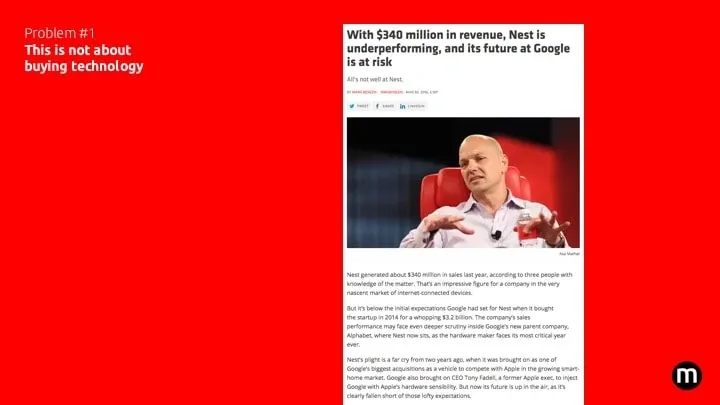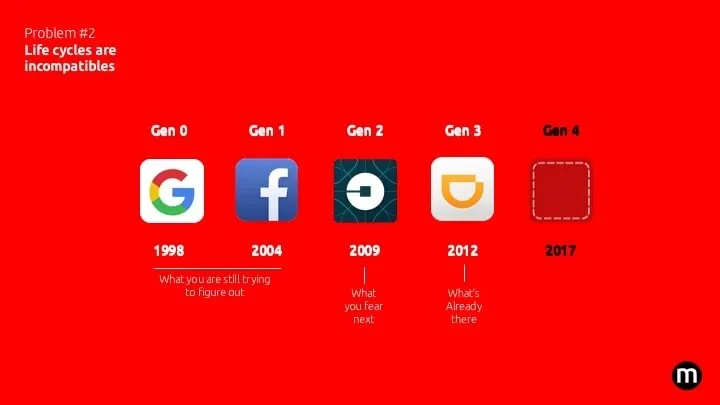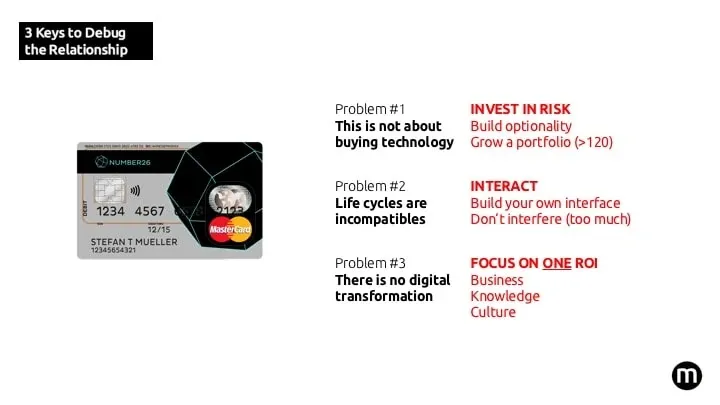When corporates meet startups

As a quick follow-up on my first two articles on corporate innovation (part 1 and part 2), I’ll be presenting a keynote on the relation between startups and corporations in Europe, for companies in the mobility market.
The key focus may be a tad concerning if you are a startup that doesn’t know anything about multinationals. Despite all the current hype on how this should be a match made in heaven, you actually have nothing in common. Zero. Nada. Niente. So if you think that a multinational has to be a key asset for your growth, you may want to think again.
This is not about technology

First and foremost, when corporates meet startups they often thing they’re going to eventually buy a new technology out of them. Given the global horrendous track record on this one, this is pretty absurd.
Any given multinational will pretty much halt any agile tech development by throwing resources at the startup. What was a fast, iterative process of prototyping and getting things done, will refocus on: who’s accountable of what? What shareholders will think? How legal can cope with that? Etc. Then someone key in a well-fed business unit will start to see the project appearing on its radar. Disruption you say? Other my dead body! Why would we cannibalize what we currently have going on with customers?
If you consider the recent deal between Microsoft and Linkedin, this will probably be another Yammer scenario. The best case scenario of startups and corporations working together is precisely when it’s not about technology, or acquiring a community of customers.
Although, Apple investing in Didi could be another story. If Apple undubiously want to smooth out political tension with the Chinese governments by broadcasting their “love” of local innovation, don’t be mistaken, the key thing is that they expect to learn a thing or two on mobility in a massive economy. This is a key investment in learning, unobtainable in another way for Apple.
Life cycles are incompatibles

Secondly, when startups and corporations have engaged a relationship, they soon realize that their internal clock is not running at the same frequency. This could be explained in many ways. Some of them are quite obvious, such as factoring the number of people necessary to take a decision in a culture or the other.
But there’s maybe something that you may have overlooked. Startups and multinationals don’t process market informations in the same way.
In that regard, picture the best startups as carnivorous big cats: they pounce on a key information, digest it quickly, and build what is sometime a narrow-minded vision, but also an extremely focused one. Their approach to innovation is a radical one, filtering out a lot of market information, biasing facts if need be, but feeding their own narrative and their challenger culture. Creating a reality distorsion field is not a scientific technique.
On the contrary multinationals strive for a comprehensive approach to market information, by making sense of the markets in a consensual way. They are heavy herbivores, grinding information at a slow pace, sending it back and forth the internal pipes several times, before it’s finally metabolized through committees, competitive clusters and various Gartner’s reports. They cannot catch the weak signals, the burgeoning trends, and any fast-paced markets at all because their cognitive process lag behind.
In that way, a typical multinational will be well aware of Google and Facebook, will fear Uber without having formed an opinion about it, and will have no clue on Didi Chuxing. The fact that Didi has been operating in more than 400 cities in China, and was valued as one of the few unicorns on the planet did not register yet.
You must admit that it’s quite a challenge to build a fast-paced approach to the market when your vision lags five, to ten years behind. Can you imagine getting all your emails as a single document at the end of the month when searching for a new job? This is what we are talking about.
There is no digital transformation

The last key problem is directly fed by the unprecedented level of hype around the “digital transformation”. We are talking Y2K bug level of bullshit here. The last I checked it seemed that 80% of the consulting firms where selling snake-oil solutions to become a digital organization. The fun part is actually that most of the “old economy” multinationals are pretty decent at digital, if not the real leaders on the playfield.
I realize that saying that is probably nowadays the ultimate provocation.
Now think about. For instance, we can agree that automotive manufacturers really suck at being socially connected to their market. In that regard they haven’t done their digital revolution. Nonetheless, a run-of-the-mill modern car harbours more line of code than Facebook’s infrastructure. What do you make if this? In my book, we’re talking hardcore digital technology here. That doesn’t mean that our old car manufacturers are not going to be disrupted by Apple, Tesla or Google, but don’t put that on digital incompetence. It’s more about being an industrial platform born in the early 19th century or in the late 20th.
3 Keys to debug the relationship

This all may sound dreadful. It’s not.
I believe that it’s part of the pack if you’re a startup trying to deal with a multinational, or a leading corporation trying to connect with challengers on a mission to disrupt you.
If you manage to drop the pink goggles, and cut through all the crap that is sold to you there are many reasons for corporates to meet startups and build cooperation:
Startup are a fantastic (if not the best) vehicle to explore risks that a typical multinational cannot afford to face. If you know how to deal with a strategic portfolio of risk explorers scouting the edges of your market, you’re building strong awareness and resiliency around your core business.
If your life cycles are truly incompatible, it doesn’t mean you cannot have strategic touchpoints through specific business interfaces. You don’t get this jargon? Think design studio, prototyping hub, pop-up stores, junior brand, etc.
Lastly, and this is key, as a multinational build your startup strategy around one key revenue: new business models (possible, but unlikely — this is the mother of all hype); harvesting knowledge on future markets (think Apple); or rebooting your innovator’s culture.
In conclusion you may want to follow the white rabbit through to La-La Land. I’m not saying you shouldn’t. I’m saying you should know why you would do it and have a sound strategy about it.




